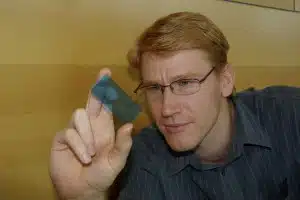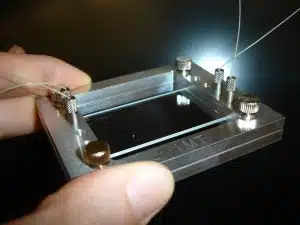Using microscopic streams of liquid to separate valuable metals from dissolved rock could revolutionise mineral processing, according to researchers at the University of South Australia.
The researchers already have shown the technique can be used to extract copper quickly and efficiently. They believe the process can be scaled up to industrial levels and used for recovering many other minerals such as nickel, uranium, gold and platinum.

Craig Priest with a microfluidic chip. Credit: Niall Byrne, Fresh Science
The technique, known as microfluidics is already used commercially to separate and purify biological samples of proteins, DNA and blood. Applying it to mineral processing is a classic case of Australian ingenuity, says Dr Craig Priest, a postdoctoral researcher in microfluidics, presenting his work in public at Fresh Science at Melbourne Museum.
“Microfluidics is the flow of liquids along microscopic channels-some finer than a human hair-to rapidly mix, react, analyse and separate material at high efficiencies and with excellent control,” he says. “Converting rocks into metal requires many steps and precise control of physical and chemical conditions. Microfluidic streams give us this control and allow multiple industrial steps to be carried out in a single, compact device.”
Priest believes that in the next few decades the impact of microfluidics on mineral processing plants could be similar to that of microelectronics on information processing. The technology could help mineral processing plants to become more compact, highly efficient, and consume less of resources such as water and power, he says.
“Building microfluidic technologies into mineral processing plants is not without its scientific and engineering challenges, but these should not be insurmountable in an age where mineral resources are increasingly scarce and global responsibilities are recognised.”

Microfluidic extraction: Small streams of liquid containing precious metals can be processed faster and greener in compact “microfluidic chips”, Credit: Craig Priest
The microfluidics research is being undertaken at the University of South Australia’s Ian Wark Research Institute (the WARK), as part of a national effort under the direction of Prof. John Ralston to address emerging challenges facing the resource sector, which is one of Australia’s most significant industries, exporting $100 billion a year and employing 142,000 people.
This work is being carried out in collaboration with The University of Tokyo, Japan, and is supported by the Australian Research Council (ARC) Special Research Centre Scheme, ARC Linkage and Linkage International Schemes, AMIRA International, and the State Governments of South Australia and Victoria.
Craig Priest is one of 15 early-career scientists presenting their research to the public for the first time thanks to Fresh Science, a national program sponsored by the Federal Government.
Other stories released today:
- Imaginary friends, real benefits (Vic); and
- Bilbies bring new life to desert dunes (NSW)
For further information, contact Craig Priest on 0437 299 510.
For Fresh Science contact: Sarah Brooker on 0413 332 489 and Niall Byrne on 0417 131 977 or niall@freshscience.org.
Vision Opportunities: Photo of microfluidic chip, graphic of microfluidic extraction.



 Fresh Science is on hold for 2022. We will be back in 2023.
Fresh Science is on hold for 2022. We will be back in 2023.